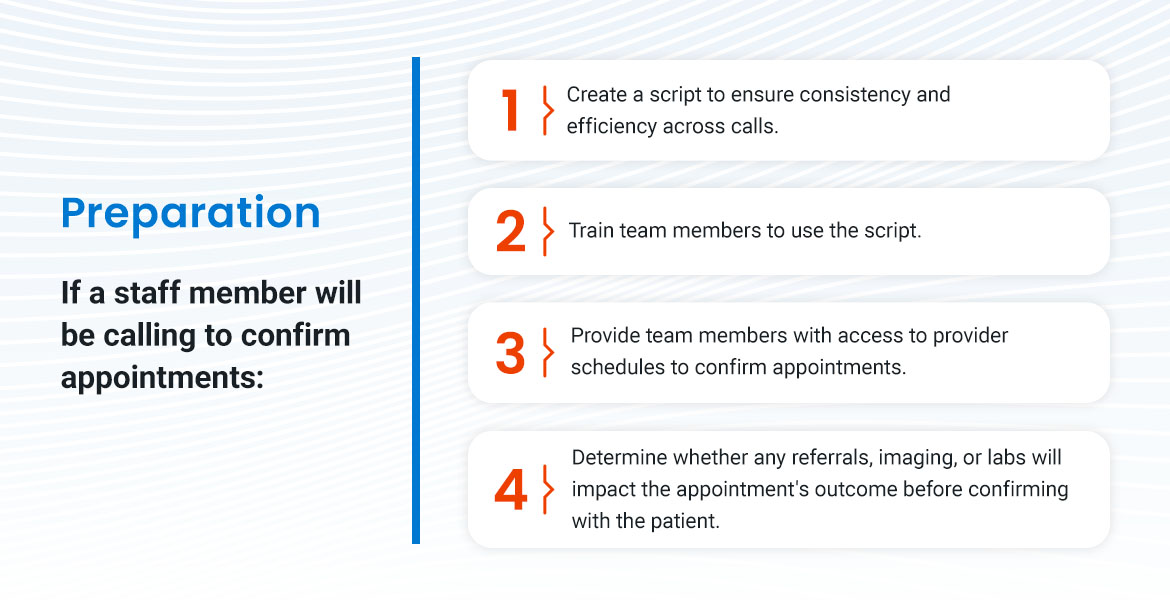In the healthcare industry, encouraging patients to make and keep appointments is critical for organizational success. When patients miss their appointments, you miss opportunities to serve others and waste costly resources. A well-executed confirmation process helps providers and office managers address these issues while building stronger patient relationships. The beginner’s guide to patient appointment confirmations details everything you need to know to create an efficient process to boost patient and facility success.
Why is Appointment Confirmation Important?
Appointment confirmation is essential for many healthcare facilities and businesses. These notifications allow providers to remain on schedule and fill empty time slots, allowing more patients to receive quality care while reducing wait times. This enhanced communication can also improve a facility’s bottom line as teams reduce no-shows and allow for more efficient patient movement. Confirmations enable businesses to see benefits such as:
- Reducing administrative workflows: Utilizing a comprehensive appointment confirmation solution empowers you to reduce administrative workloads. By automating parts of the confirmation process, you can give time back to your staff by reducing the need to make manual calls or engage in back-and-forth with patients to obtain essential information.
- Boosting patient satisfaction: Advanced confirmation is critical to increasing patient retention and satisfaction. You can strengthen your patient relationships by showing that you value each person’s time and seek to deliver quality and timely care they can rely on.
- Preventing financial losses: No-shows drastically impact healthcare practices. Along with affecting patient health conditions and delays in treatment, no-shows harm your bottom line. Although each facility will experience the effects of a no-show differently, recent findings show that 67,000 no-shows can equate to more than $7 million lost in the healthcare system (National Library of Medicine). For facilities using resources like MRI machines or X-rays, these costs can create major financial strains within an organization.
- Ensuring timeliness: Timeliness is vital on both ends of the care spectrum. As a provider or practice manager, you understand that late patients and other setbacks can quickly impact your day and your ability to deliver quality services to other patients. Additionally, patients expect you to uphold their appointment times so they can meet their other commitments and continue with their day.
How to Confirm an Appointment with Patients
Once you discover what methods work best for your team and patients, the patient appointment confirmation process can be simple. There are several steps you can take before sending a confirmation notice and tips you can follow to increase patient engagement and reduce no-show rates. Here’s how you can confirm appointments:
1. Preparation

For effective confirmation and to ensure you have all the information necessary to deliver quality services, you must follow several preparation steps. If a staff member will be calling to confirm appointments, create a script to ensure consistency and efficiency across calls. Train team members to use the script and ensure they provide adequate notice to each patient. Provide team members with access to provider schedules to confirm appointments or quickly work with patients to reschedule for another visit. Determine whether any referrals, imaging, or labs will impact the appointment’s outcome before confirming with the patient.
2. Confirmation
When it’s time to confirm an appointment, there are several methods you can try. The specific method you choose should reflect your patient needs and reduce your staff’s workload. Confirmation is effective regardless of the initial format as long as you acquire all necessary information to deliver quality care.
Whether you want to have staff members make calls, plan to use emails or texts, or encourage patients to utilize an online patient portal, you must collect the same type of information from each patient:
- Directions to arrive at the correct facility or department
- Knowledge of cancellation policies or procedures if plans change
- Changes to information such as phone numbers, addresses, or insurance providers
- Expectations of the visit, including pre-visit instructions and after-care if necessary
- Prescription information and allergies
- Payment information and processes
- Accommodations a patient may need
- Any referrals, imaging, or lab results that could impact services
3. The Follow-Up
You can further reduce no-shows, boost patient engagement, and ensure facility efficiency, even after receiving patient confirmation. Any staff handling the confirmation process must take time to note the result of each call, including whether they left a voicemail, reached a disconnected number, rescheduled a patient, or experienced a different outcome. Send an additional notice or follow-up to each patient as their appointment day nears. For example, if a patient confirms an appointment a week before their scheduled time by calling your office, you can reduce the likelihood of a no-show by sending them a reminder a day or two before the appointment.
Additional Tips for Reducing No-Shows
Although sending notifications and documenting patient responses can significantly impact your facility, several tips can further enhance your process:
- Use multiple methods to reach out: Interact with patients in various ways to determine what methods they prefer and which are most effective. For example, you can utilize phone and email confirmations. Some patients may prefer the intimacy of speaking with a team member, while others will enjoy the convenience of clicking a link to verify their information. The more you reach out, the less likely your patients will forget or neglect their appointment, so take advantage of your various resources and strategies.
- Provide an incentive to show up: Many patients can benefit from having an incentive to meet appointment times. While promoting good health is a worthwhile incentive alone, using other rewards or knowledge systems can increase engagement and encourage patients to make more visits. One method is to offer discounts for other services, especially those that insurance providers are less likely to cover, such as some cosmetic services. You can also take an educational approach to incentivize your patients. For example, if your facility provides mammograms, you can highlight in confirmation emails or texts that mammography has contributed to a 40% reduction in breast cancer mortality over the last three decades (American College of Radiology).
- Have a cancellation or no-show policy: Cancellation policies could reduce scheduling gaps. Create a thorough policy and ensure all staff members understand how to enforce it. Have all patients review and sign the policy when they complete registration forms so they know what to expect if they miss or change an appointment. You can implement no-show or last-minute cancellation fees to encourage patients to show up or, at the very least, provide you with adequate notice so you can fill your schedule with another patient.
Leveraging Technology to Maximize Engagement
Finding the right solution provider is key to creating an efficient and effective process. At Rectangle Health, you can find the easy-to-use technology, passionate team, and convenient features you need to transform your schedule and empower your patients.
Bridge™Engagement is a comprehensive solution that connects you with patients automatically by using their preferred communication methods at ideal times and customizing appointment messages. This platform offers a mirage of features, such as ‘schedule now’ links, rescheduling options, recall notifications, and opportunities to fill your open spots with patients needing an appointment.
Along with enhancing communication, Bridge Engagement empowers you to engage patients in a modern way. With appointment reminders, confirmation notifications, and automatic schedule clearing, you can enhance patient outcomes while improving your bottom line.
Confirm Patient Appointments with Rectangle Health
Rectangle Health powers the business of healthcare, and we understand how to address the problems your facility faces. More than 36,000 healthcare providers currently use our solution, and we encourage you to join the ranks. See how our solutions can work for you by requesting a demo.

